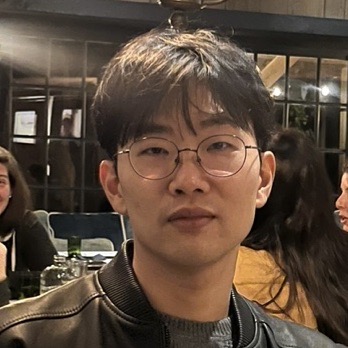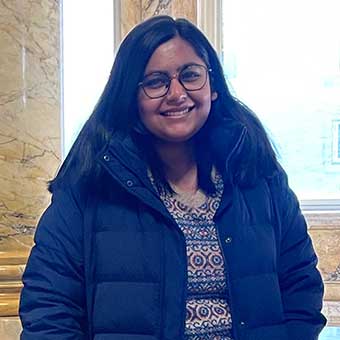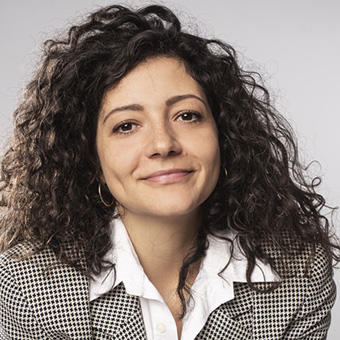2024 Graduate Research Funding

Holocaust & Memory: Grandchildren of Survivors, Grandchildren of Perpetrators
Grandchildren of Holocaust survivors and grandchildren of Holocaust perpetrators are important groups to examine because they are typically the last generation to have had a formative relationship with the generation of contemporaries of the Holocaust. As there are fewer contemporaries and contemporaries’ children left, grandchildren are often seen, by themselves and by others, as responsible for carrying on their family history. My dissertation studies these grandchildren in the United States, Germany, Austria, and Israel, asking what it means to be the grandchild of a survivor or of a perpetrator, why this identity matters to such individuals, and how they relate to the history and memory of the Holocaust. With the Mandel Graduate Research Grant, I will study these grandchildren in Austria by interviewing them and conducting archival research.

Animating Belonging: The Role of Animate Objects in Native American and First Nations Novels
My dissertation investigates the significance of animate objects in twentieth and twenty-first century Native American and First Nations Canadian novels, particularly those set on the American Plains and Canadian Prairies. I examine how objects like sacred seeds, ritual drums, and medicine bundles function as active characters, shaping the protagonists' identities within their tribal communities. Through close analysis of novels such as D'Arcy McNickle's "Wind from an Enemy Sky," James Welch's "Fools Crow," Richard Wagamese's "Keeper'n Me," and Diane Wilson's "The Seed Keeper," I argue that these animate objects serve as conduits for cultural transmission, community cohesion, and personal growth. They offer alternative connections to Native land in the face of historical and contemporary challenges, embodying resilience and cultural survival. By reframing discussions around Native belonging to include animate objects, I aim to challenge existing scholarly narratives and educate both non-Natives and Natives alike on the significance of these objects in literature.

Poetry and Self-Love: Thomas Love Peacock and the Poet's Amour-propre
The widely shared apprehension that the humanities are in crisis, when we look at history, is hardly a new thing. In 19th-century Britain, writers were already discussing among themselves whether literature mattered intellectually and morally. Most famously, Thomas Peacock's 1820 essay "The Four Ages of Poetry" argued against the utility of poetry in modern society, to which the Romantic poet Percy Shelley responded in his "A Defence of Poetry." However, the centrality of the question of natural benevolence in both writers' discussion of poetry remains largely unexplored, a lacuna directly addressed in my project.

Orientalism, Commodification and Adoption: Tracing the History of Chinese Adoption in the American Social Welfare Archives
Unlike transracial adoption from Korea and Vietnam, which emerged in the context of war, transracial adoption from China to the United States is primarily attributed to the One Child Policy (1979-2015). As such, it has been viewed as separate and distinct—a historical event without a past. While China’s restrictive reproductive policy undeniably contributed to the sudden rise of Americans adopting from China, I argue that such an overly simplistic causal narrative overlooks broader historical context and continuity. My goal, then, is to trace a genealogy of Chinese adoption that begins not with the One Child Policy, but with China as an object of American fascination and producer of exotic goods and commodities. To this end, I turn to the Social Welfare History Archives housed at the University of Minnesota, specifically the International Social Service (ISS) American Branch records, the National Council for Adoption records, the William Pierce Papers, and the Child Welfare League of America (CWLA) records. The ISS provided intercountry adoption casework services for nearly eighty years and includes over a thousand case files on adoption from Hong Kong. The National Council for Adoption contains the William Pierce Papers which includes documentation of the Hague Convention on International Adoption which established international standard practices for intercountry adoptions. Lastly, the CWLA records focus on adoption policy and legislation within the United States. Taken together, these collections will offer insight into the perspectives of adoptive parents, American opinion about China and its people, and international adoption policy.

Infrastructure and Bereavement in Crematorial Tourism on the Ganges: A look at Simariyah Ghat
Simariya ghat (steps leading to a river) is located in the Begusarai district of the Indian state of Bihar about 120 odd kilometers (75 miles) from the capital city of Patna. Built at the banks of the river Ganga, as cremation grounds in North India usually are, the ghat is an important node in the circuit of mortuary practices in the state, in addition to being a sacred location where the once-in-twelve-years Ardhakumbha mela takes place. More recently, it has inspired the attention of the Bihar state government which has promised a Rs 100 crore ($12 million USD) developmental project at the ghat in order to raise its glory to that of Har ki Pauri (literally translated as “God’s Steps,'' arguably the holiest and most popular tourist attraction at the banks of river Ganga in the neighboring state of Uttar Pradesh). Significantly, one of the main promises of the “development campaign” was the building of an electric crematorium at the ghat to ease the problems faced by the mourners. Through the observation of death and dying experiences in the region, I hope to ask - how do bereavement experiences become part of affective and infrastructural projects of “development” in postcolonial contexts? The aim of my study is to understand: 1) strategies and/or ambivalences regarding “development;” 2) the crafting of relatedness through affective ties, care work and labor; and 3) the imbrication of caste and gender in its region specific contexts.

Medical Atrocities and Postwar Repercussions amongst Hungarian Roma in the Lackenback Roma Internment Camp
I study the experiences of Jews and Roma who endured sterilization and castration experiments in the National Socialist death and concentration camps of Auschwitz, Birkenau, and Lackenbach in the years between 1942 to 1945. While I study these medical atrocities happening during the war years, I am also interested in the postwar repercussions. The Hungarian Romani kin, the Lovara were among the majority of the survivors in the Lackenbach Romani internment camp, where sterilization experimentation with an herbal plant was planned according to the findings of the American Military Tribunal at the Nuremberg Doctors’ Trial. Since the tribunal at the time of their investigation did not find any survivor sterilized by the plant, the defendants of this means of mass sterilization were acquitted in 1947. Yet evidence points to the mass cultivation and preparation of the herbal substance and its testing on concentration camp inmates. In my dissertation, one chapter will be dedicated to the investigation of the sterilization agent used in the Lackenbach camp on the Lovara Roma. In order to establish its impact on Lovara individuals and families, I will visit archives in Germany and Vienna to find more sources with the generous support of the Graduate Research grant from the Mandel Center.